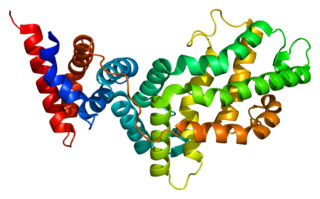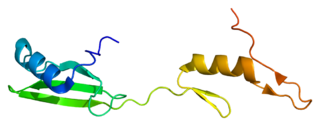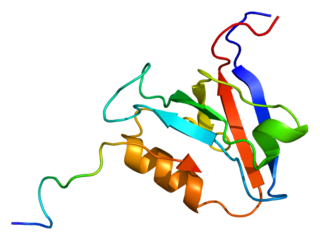Serine/threonine-protein kinase N2 is an enzyme that in humans and Strongylocentrotus purpuratus is encoded by the PKN2 gene. [5] [6] [7]
Serine/threonine-protein kinase N2 is an enzyme that in humans and Strongylocentrotus purpuratus is encoded by the PKN2 gene. [5] [6] [7]
PKN2 has been shown to interact with:

Protein kinase C, zeta (PKCζ), also known as PRKCZ, is a protein in humans that is encoded by the PRKCZ gene. The PRKCZ gene encodes at least two alternative transcripts, the full-length PKCζ and an N-terminal truncated form PKMζ. PKMζ is thought to be responsible for maintaining long-term memories in the brain. The importance of PKCζ in the creation and maintenance of long-term potentiation was first described by Todd Sacktor and his colleagues at the State University of New York at Brooklyn in 1993.

RAC(Rho family)-alpha serine/threonine-protein kinase is an enzyme that in humans is encoded by the AKT1 gene. This enzyme belongs to the AKT subfamily of serine/threonine kinases that contain SH2 protein domains. It is commonly referred to as PKB, or by both names as "Akt/PKB".

Protein kinase C delta type is an enzyme that in humans is encoded by the PRKCD gene.

Phosphatidylinositol 3-kinase regulatory subunit alpha is an enzyme that in humans is encoded by the PIK3R1 gene.

RAS p21 protein activator 1 or RasGAP, also known as RASA1, is a 120-kDa cytosolic human protein that provides two principal activities:

LIM domain kinase 1 is an enzyme that in humans is encoded by the LIMK1 gene.

Mitogen-activated protein kinase kinase kinase 11 is an enzyme that in humans is encoded by the MAP3K11 gene.

Cytoplasmic protein NCK1 is a protein that in humans is encoded by the NCK1 gene.

Rho GTPase-activating protein 1 is an enzyme that in humans is encoded by the ARHGAP1 gene.

Serine/threonine-protein kinase N1 is an enzyme that in humans is encoded by the PKN1 gene.

Cyclin-dependent kinase 5 activator 1 is an enzyme that in humans is encoded by the CDK5R1 gene.

Tyrosine-protein phosphatase non-receptor type 13 is an enzyme that in humans is encoded by the PTPN13 gene.

Rho guanine nucleotide exchange factor 7 is a protein that in humans is encoded by the ARHGEF7 gene.

Polo-like kinase 3 (Drosophila), also known as PLK3, is an enzyme which in humans is encoded by the PLK3 gene.

Cytoplasmic protein NCK2 is a protein that in humans is encoded by the NCK2 gene.

Mitogen-activated protein kinase kinase kinase 10 is an enzyme that in humans is encoded by the MAP3K10 gene.

Growth factor receptor-bound protein 14 is a protein that in humans is encoded by the GRB14 gene.

Ras GTPase-activating protein 3 is an enzyme that in humans is encoded by the RASA3 gene.

In the field of biochemistry, PDPK1 refers to the protein 3-phosphoinositide-dependent protein kinase-1, an enzyme which is encoded by the PDPK1 gene in humans. It is implicated in the development and progression of melanomas.

BIM-1 and the related compounds BIM-2, BIM-3, and BIM-8 are bisindolylmaleimide-based protein kinase C (PKC) inhibitors. These inhibitors also inhibit PDK1 explaining the higher inhibitory potential of LY33331 compared to the other BIM compounds a bisindolylmaleimide inhibitor toward PDK1.